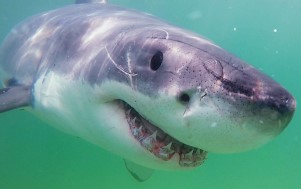
Sharks ‘adapting their movements and routines,’ great white researchers discover
Do great white sharks change their behaviors in different environments, or do the apex predators follow the same routines regardless of location?
Researchers recently set out to solve this shark puzzle, as they reportedly discovered great white behaviors by attaching smart tags and cameras to their fins.
Great whites adapt their movements and routines based on the specific habitat they’re hunting in, according to the shark scientists.
“… The sharks are adapting their movements and routines to suit their local environment, rather than behaving the same way everywhere they’re found,” said shark researcher Oliver Jewell.
In the study, 21 white sharks from small juveniles to large adults were fitted with motion-sensitive biologging tags along the California coast in different environments — offshore islands, coastal headlands, and an inshore cove.
The tags were attached for up to six days at a time and measured swimming depths and body movements, before they detached and floated to the surface.
The California coast provided a unique space to conduct the work, not only because researchers had been studying this specific population for decades, but the area is home to both juvenile and adult white sharks.
“White sharks visit the same areas of central California year after year, with some seen in the same spot for 30 years or more,” said Jewell, a researcher at the University of Western Australia.
“We were looking to see what shapes their movements and routines while they are there,” Jewell added.
Related Articles
Cape Cod shark researchers ID nearly 100 ‘new’ great whites: ‘One of the largest photo-ID databases of individual white sharks worldwide’
Sharks scavenge carcass of another North Atlantic right whale found dead off East Coast
Cape Cod Dolphin Rescue Center treats first stranded dolphin
15-foot dead shark washes up on beach, leads to ‘treasure trove’ of info for Northeast researchers
Massive shark tagged by Cape Cod researcher makes shark science history: ‘A dream come true’
During the day, sharks at all sites were generally more active — swimming up and down the water column, suggesting they were actively searching for prey.
However, sharks showed more active behavior at both dawn and dusk in places where they were thought to feed on fish rather than marine mammals.
“We found the greatest differences in movements were from sharks from different areas, while the size of the shark and time of day were also important,” Jewell said.
It’s important to review the location of a shark when considering why it might be behaving a certain way, the scientist added.
“Hopefully, we can apply the research in a number of ways going forward — we’ve already been tagging more sharks in more areas, and will follow this up with further studies,” Jewell said.
Great white sharks will be returning to Cape Cod’s waters over the next few months, where they feed on seals throughout the summer and fall. Many sharks also head farther north to Maine and Canada.
This recent research was a part of Monterey Bay Aquarium’s “Project White Shark” and led by Jewell, a former Murdoch University PhD candidate, with Harry Butler Institute and the School of Environmental and Conservation Sciences — in collaboration with Oregon State University, Stanford University and California State University Monterey Bay.


